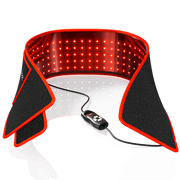Red light therapy has become a responsible method known for participating actively in promoting angiogenesis, the creation of new blood vessels from the pre-existing ones. This is critical to a number of physiological functions and pathophysiological applications like wound healing, tissue regeneration and reversing ischemia.
In this blog post, we will explore different mechanisms of red light angiogenesis, and this time - with its wide range of possible applications.
The Molecular Mechanisms behind Red Light-Induced Angiogenesis
Among these methods, red light therapy of 630, 660, 850 and 940 nm near infrared light stimulates many mechanisms intracellular, leading to those cellular processes supporting angiogenesis. The primary pathway through which this occurs is via the increased activation of mitochondrial chromophores, of which cytochrome c oxidase is the most well characterized, which in turn enhances cellular respiration and energy production.
This increased cellular metabolism also increases the production of the signaling molecules, reactive oxygen species (ROS), which induce angiogenic growth.
Red light therapy also increases angiogenic factors, a group of substances that are responsible for the growing of new blood vessels, such as Vascular Endothelial Growth Factor (VEGF), Fibroblast Growth Factor (FGF), and Nitric Oxide (NO).
These factors promote the proliferation, migration and capillary-like tube formation of endothelial cells. Through increasing these cellular processes, red light therapy, in a very potent and safe manner, will stimulate the development of new blood vessels.

Using Red Light Therapy for fast wound healing
One of the great uses of Red Light Therapy It increases the supply of oxygen and nutrition to damaged tissues by promoting angiogenesis, thus the healing process is accelerated. Its made even easier in the case of chronic wounds (e.g., diabetic ulcers) when poor blood flow impedes healing.
Studies Estimation Across various studies, red light therapy has been shown to reduce inflammation, increase collagen production and tissue granulation. Red light therapy has been shown to greatly enhance wound healing in patients with diabetic foot ulcers, as demonstrated in the study published in the journal Photomedicine and Laser Surgery. These results that suggest red light therapy has therapeutic effects which could be used in clinical practice augmented by promotion of tissue repair and regeneration.
Enhancing Circulation and Ischemic Blood Flow Recovery
Low blood flow, especially to tissues, in ischemic conditions can have severe complications, that include tissue necrosis and organ failur Studies show that red light therapy helps improve circulation and restore proper blood flow in conditions like these. It increases vessel formation resulting in the blood vessels getting restored into the ischemic tissues, which prevents the risks of developing complications.
Studies have shown that red light therapy (RLT) can increase micro-blood circulation and improve endothelial function. One study found that red light therapy increased blood flow and reduced pain in patients with peripheral artery disease (PAD). This shows that red light therapy could help in treating ischemic conditions by being a non-invasive way to treat and boost vascular health for good.
Species Specific Involvement of mTOR in Angiogenesis
New vessel formation as a target makes red light therapy a very versatile therapeutic agent. For example, in the context of cancer therapy red light therapy can be employed to induce angiogenesis in normal tissues and inhibit tumor growth. To take the same thing to a different level, we carefully control the targeting of our treatment using specific parameters of the treatment like wavelength, dosage and time of exposure.
Red light therapy is also often paired with other treatment types to boost its effectiveness For instance, combining red light therapy with hyperbaric oxygen therapy (HBOT) has been proven to encourage angiogenesis and tissue restoration synergistically. The patient who could potentially benefit the most would be a patient with medical complexities where their medical conditions require multiple levels of treatment.

Red-Light Therapy Matters: The Versatile Angiogenic Potential of Red Light
Given the broad angiogenic needs across a variety of disorders, the adaptability of red light therapy makes it an important tool for clinical use as well as home use. The uses of red light therapy
- Skin Care:
Some of the best uses that it is used for is for anti-age benefits on the skin. These factors helps to minimize wrinkles, fine lines and age spots by boosting collagen production and enhancing skin elasticity.
- Sports Injuries:
Red light therapy is often used by athletes for muscle strains, ligament sprains, joint pain and post-joint-replacement recovery.
- Chronic Pain:
Red Light Therapy practicioners havee noticed how red light therapy decreases pain from those suffering from conditions such as arthritis, fibromyalgia or neuropathy.
- Wound Healing:
Red light therapy also hastens healing of certain wounds, such as surgical incisions, diabetics ulcers, and other chronic wounds.
In addition, user-friendly red light therapy devices, such as products from all bestqool offers, are developed for easy-at-home treatment allowing users to benefit from this therapy without having to leave their residence. These devices are using optimal wavelengths (630nm, 660nm, 850nm, and 940nm) for ideal penetration and efficacy to improve therapeutic outcomes.
Conclusion
Red light therapy Red light therapy is becoming an incredibly versatile and effective form of photo biomodulation for promoting angiogenesis, which is the growth of new blood vessels. Red light therapy is useful for a variety of clinical needs by promoting cellular processes, the production of angiogenic factors, and selectively stimulating angiogenesis.
The pro-angiogenic effects of red light therapy show exciting promise across the spectrum of therapeutic interventions, from wound healing and tissue regeneration, to ischemic conditions with poor circulation.
With further research already uncovering the mechanisms behind, applications and wellness secrets of red light therapy, it may only be a matter of time before we drastically change how we treat vascular and regenerative health concerns, or at least test out red light therapy as a no-side-effect alternative or add-on for those suffering.













 Small
Small

 Moderate
Moderate

 Moderate
Moderate

 Moderate
Moderate

 Full
Full



